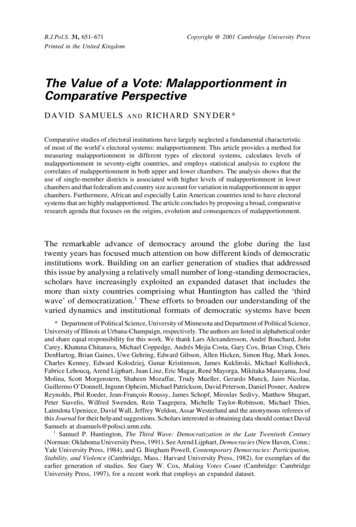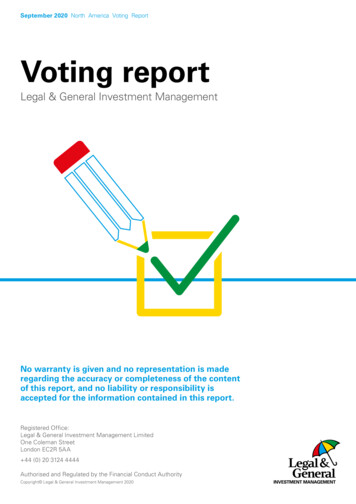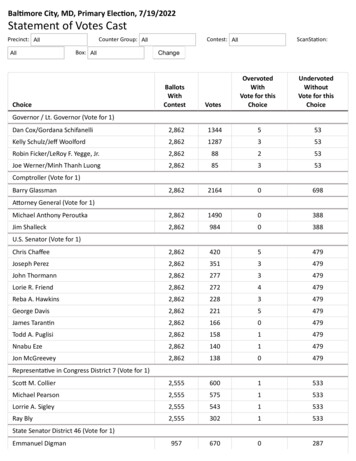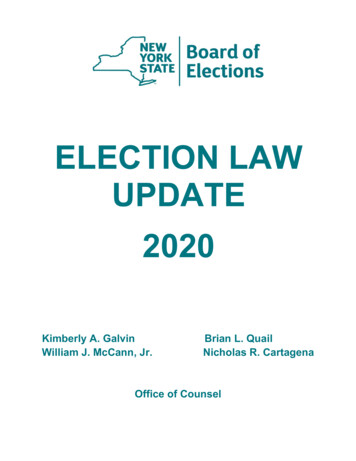
Transcription
B.J.Pol.S. 31, 651–671Printed in the United KingdomCopyright @ 2001 Cambridge University PressThe Value of a Vote: Malapportionment inComparative PerspectiveDAVID SAMUELSANDRICHARD SNYDER*Comparative studies of electoral institutions have largely neglected a fundamental characteristicof most of the world’s electoral systems: malapportionment. This article provides a method formeasuring malapportionment in different types of electoral systems, calculates levels ofmalapportionment in seventy-eight countries, and employs statistical analysis to explore thecorrelates of malapportionment in both upper and lower chambers. The analysis shows that theuse of single-member districts is associated with higher levels of malapportionment in lowerchambers and that federalism and country size account for variation in malapportionment in upperchambers. Furthermore, African and especially Latin American countries tend to have electoralsystems that are highly malapportioned. The article concludes by proposing a broad, comparativeresearch agenda that focuses on the origins, evolution and consequences of malapportionment.The remarkable advance of democracy around the globe during the lasttwenty years has focused much attention on how different kinds of democraticinstitutions work. Building on an earlier generation of studies that addressedthis issue by analysing a relatively small number of long-standing democracies,scholars have increasingly exploited an expanded dataset that includes themore than sixty countries comprising what Huntington has called the ‘thirdwave’ of democratization.1 These efforts to broaden our understanding of thevaried dynamics and institutional formats of democratic systems have been* Department of Political Science, University of Minnesota and Department of Political Science,University of Illinois at Urbana-Champaign, respectively. The authors are listed in alphabetical orderand share equal responsibility for this work. We thank Lars Alexandersson, André Bouchard, JohnCarey, Khatuna Chitanava, Michael Coppedge, Andrés Mejia Costa, Gary Cox, Brian Crisp, ChrisDenHartog, Brian Gaines, Uwe Gehring, Edward Gibson, Allen Hicken, Simon Hug, Mark Jones,Charles Kenney, Edward Kolodziej, Gunar Kristinnson, James Kuklinski, Michael Kullisheck,Fabrice Lehoucq, Arend Lijphart, Juan Linz, Eric Magar, René Mayorga, Mikitaka Masuyama, JoséMolina, Scott Morgenstern, Shaheen Mozaffar, Trudy Mueller, Gerardo Munck, Jairo Nicolau,Guillermo O’Donnell, Ingunn Opheim, Michael Patrickson, David Peterson, Daniel Posner, AndrewReynolds, Phil Roeder, Jean-François Roussy, James Schopf, Miroslav Sedivy, Matthew Shugart,Peter Siavelis, Wilfred Swenden, Rein Taagepera, Michelle Taylor-Robinson, Michael Thies,Laimdota Upeniece, David Wall, Jeffrey Weldon, Assar Westerlund and the anonymous referees ofthis Journal for their help and suggestions. Scholars interested in obtaining data should contact DavidSamuels at dsamuels@polisci.umn.edu.1Samuel P. Huntington, The Third Wave: Democratization in the Late Twentieth Century(Norman: Oklahoma University Press, 1991). See Arend Lijphart, Democracies (New Haven, Conn.:Yale University Press, 1984), and G. Bingham Powell, Contemporary Democracies: Participation,Stability, and Violence (Cambridge, Mass.: Harvard University Press, 1982), for exemplars of theearlier generation of studies. See Gary W. Cox, Making Votes Count (Cambridge: CambridgeUniversity Press, 1997), for a recent work that employs an expanded dataset.
652SAMUELS AND SNYDERespecially vigorous in the subfield of electoral studies, where a burgeoningcross-national literature has emerged on the political consequences of electorallaws.2Curiously, however, this literature has largely neglected a fundamentalcharacteristic of many of the world’s electoral systems: malapportionment, orthe discrepancy between the shares of legislative seats and the shares ofpopulation held by geographical units.3 This discrepancy has important politicalramifications. From the standpoint of democratic theory, for example,malapportionment violates the ‘one person, one vote’ principle4 which,according to Dahl, is a necessary condition for democratic government.5Taagepera and Shugart regard malapportionment as a ‘pathology’ of electoralsystems, and Gudgin and Taylor conclude that it may be ‘ethically unjustifiable’.6 Given these strong normative claims about malapportionment, itis surprising that students of democracy have devoted so little attention to thistopic.In addition to these normative issues, malapportionment can have importantconsequences for policy making. Recent work on cases as distinct as the UnitedStates, Brazil, Russia, Argentina, Japan and Mexico shows that malapportionment shapes the decision-making contexts of incumbent executives andlegislators in ways that have major effects on policy choices and coalitional2See, for example, Cox: Making Votes Count; Lijphart: Democracies; Arend Lijphart, ElectoralSystems and Party Systems: A Study of Twenty-Seven Democracies, 1945–1990 (Oxford: OxfordUniversity Press, 1994); Rein Taagepera and Matthew S. Shugart, Seats and Votes: The Effects andDeterminants of Electoral Systems (New Haven, Conn.: Yale University Press, 1989).3Exceptions include Burt L. Monroe, ‘Disproportionality and Malapportionment: MeasuringElectoral Inequity’, Electoral Studies, 13 (1994), 132–49; Burt L. Monroe, ‘Bias and Responsivenessin Multiparty and Multigroup Representation’ (paper presented at the Political Methodology SummerMeeting, UC San Diego, 1998); Burt L. Monroe, ‘Mirror Representation in the Funhouse: SystematicDistortions in the Legislative Representation of Groups’ (unpublished paper, University of Indiana,1998); Lijphart, Electoral Systems and Party Systems, pp. 124–30; Bernard Grofman, WilliamKoetzle and Thomas Brunell, ‘An Integrated Perspective on the Three Potential Sources of PartisanBias: Malapportionment, Turnout Differences, and the Geographic Distribution of Party VoteShares’, Electoral Studies, 16 (1997), 457–70; Alfred Stepan, ‘Toward a New Comparative Analysisof Democracy and Federalism’ (paper prepared for the Conference on Democracy and Federalism,Oxford University, 1997); and Ron Johnston, David Rossiter and Charles Pattie, ‘Integrating andDecomposing the Sources of Partisan Bias: Brookes’ Method and the Impact of Redistricting in GreatBritain’, Electoral Studies, 18 (1999), 367–78.4Michael Balinski and H. Peyton Young, Fair Representation: Meeting the Ideal of One Man,One Vote (New Haven, Conn.: Yale University Press, 1982).5Robert A. Dahl, Polyarchy: Participation and Opposition (New Haven, Conn.: Yale UniversityPress, 1971), p. 2.6Taagepera and Shugart, Seats and Votes: The Effects and Determinants of Electoral Systems,pp. 17–18; Graham Gudgin and Peter J. Taylor, Seats, Votes, and the Spatial Organisation ofElections (London: Pion Limited, 1979). In addition Grofman et al. (‘An Integrated Perspective onthe Three Potential Sources of Partisan Bias’) have recently shown that malapportionment, along withturnout differences and the geographic distribution of party votes, can contribute to partisan ‘bias’,that is, asymmetry in how party vote shares are translated into seat shares in the national legislature.See also Johnston et al., ‘Integrating and Decomposing the Sources of Partisan Bias’.
The Value of a Vote653dynamics.7 These single-country studies suggest that malapportionment canhave an important impact on executive–legislative relations, intra-legislativebargaining and the overall performance of democratic systems.Despite the normative and practical importance of malapportionment, weknow of no cross-national, comparative study of this key dimension ofelectoral systems.8 In this article, we seek to fill this gap by providing amethod for calculating malapportionment cross-nationally and by measuringthe degree of malapportionment in seventy-eight countries.9 We show thatlevels of malapportionment vary significantly in both upper and lowerchambers and across regions, with African and especially Latin Americancountries having comparatively high levels of malapportionment. We alsoexplore how important institutional variables, such as federalism, bicameralism and the structure of electoral districts, are associated with malapportionment. The final section concludes and provides suggestions for futureresearch.7United States: Mathew D. McCubbins and Thomas Schwartz, ‘Congress, the Courts, and PublicPolicy: Consequences of the One Man, One Vote Rule’, American Journal of Political Science, 32(1988), 388–415; Brazil: Barry Ames, Political Survival: Politicians and Public Policy in LatinAmerica (Berkeley: University of California Press, 1987); Russia: Daniel Treisman, After theDeluge: The Politics of Regional Crisis in Post-Soviet Russia (Ann Arbor: University of MichiganPress, 1999); Argentina: Kent Eaton, ‘Party, Province, and Coparticipación: Tax Reform inArgentina’ (paper prepared for the 1996 Meeting of the American Political Science Association, SanFrancisco, 1996); Edward L. Gibson and Ernesto Calvo, ‘Federalism and Low-MaintenanceConstituencies: Territorial Dimensions of Economic Reform in Argentina’, Studies in ComparativeInternational Development, forthcoming; Japan: Michael Thies, ‘When Will Pork Leave the Farm?Institutional Bias in Japan and the United States’, Legislative Studies Quarterly, 23 (1998), 467–91;Mexico: Alberto Diaz-Cayeros, ‘Federal Resource Allocation under a Dominant Party: RegionalFinancial Transfers in Mexico’ (paper prepared for the 1996 Meeting of the American PoliticalScience Association, San Francisco, 1996); Scott Morgenstern, ‘Spending for Political Survival:Elections, Clientelism, and Government Expenses in Mexico’, División de Estudios Polı́ticos, No.69 (Centro de Investigaciones y Docencia Económicas, Mexico, 1996).8Many studies explore apportionment in the United States (such as Gary W. Cox and JonathanN. Katz, ‘The Reapportionment Revolution and Bias in US Congressional Elections’, AmericanJournal of Political Science, 43 (1999), 812–41), and a handful of single-country studies analyseother cases (e.g., Hiroyuki Hata, ‘Malapportionment of Representation in the National Diet’, Lawand Contemporary Problems, 53 (1990), 153–70, on Japan; and Jairo M. Nicolau, ‘As Distorçõesna Representação dos Estados na Câmara dos Deputados Brasileiros’, DADOS: Revista de CiênciasSociais, 40 (1997), 441–64, on Brazil). Lijphart’s bivariate coding of countries (in Electoral Systemsand Party Systems, p. 130) as either ‘malapportioned’ or ‘not malapportioned’ illustrates theimpediments to cross-national research posed by the lack of an index for measuring levels ofmalapportionment.9Most of our cases would be classified as ‘free’ according to Freedom House (Freedom House.2000. ‘Country Ratings’, on-line at http://www.freedomhouse.org/ratings/, accessed 14 April 2000).We do include some cases with ‘semi-free’ elections, however, because if fully democraticprocedures are ever established in these cases, it is likely that current patterns of malapportionmentwill shape the dynamics of the emerging democratic regime.
654SAMUELS AND SNYDERMEASURING MALAPPORTIONMENTAt the broadest level, we can describe electoral systems as either perfectlyapportioned or malapportioned. In a perfectly-apportioned system, no citizen’svote weighs more than another’s. The Israeli Knesset exemplifies such a system:its 120 members are elected in a single, national at-large district. Four otherlower chambers in our sample are perfectly-apportioned: The Netherlands, Peru,Namibia and Sierra Leone.In a malapportioned system, by contrast, the votes of some citizens weighmore than the votes of other citizens. In the most extreme case, a malapportionedsystem might allocate to a single person an electoral district (say, that person’shome), one vote, and all the legislative seats. The rest of the population wouldhold all votes except one and would receive no seats. Although no real-worldelectoral system approximates this extreme, nearly all exhibit some malapportionment. Malapportionment thus seems a normal characteristic of mostelectoral systems.How can we measure the degree of malapportionment across electoralsystems? Ratios of largest-to-smallest districts might seem an obvious meansfor assessing malapportionment. However, such ratios actually prove poorindicators of malapportionment. First, district size on the basis of populationtells us little about the degree to which districts are underrepresented oroverrepresented: we also need to know how many seats are allocated to eachdistrict. Furthermore, even if we know how many seats are held by the largestand smallest districts and can therefore calculate ratios of ‘worst represented’to ‘best represented’ districts, such ratios tell us little about overall degrees ofmalapportionment. For example, even if this ratio is 50:1 (e.g., a single-memberdistrict system in which the largest district has a population fifty times greaterthan the smallest district),10 all other districts may have nearly-equivalentpopulations, and, hence, the largest and smallest districts could be extremeoutliers in a system with a low degree of average malapportionment. Althoughit may be tempting to interpret wide gaps between the best and worst representeddistricts as signs of high overall levels of inequality in electoral systems, a bettermeasure is required.With one important modification, the Loosemore–Hanby index of electoraldisproportionality (D)11 provides such a measure.12 To calculate malapportion10This is the case in India, where in 1991 the largest district for the national lower chamber (Thane)had a population of 1,744,592, whereas the smallest district (Lakshadweep) had a population of just31,665. See David Butler, Lahiri Ashok and Roy Prannoy, India Decides: Elections 1952–1995, 3rdedn. (New Delhi: Books & Things, 1995), p. 16.11Disproportionality arises when ‘political parties receive shares of legislative seats that are notequal to their shares of votes’. By contrast, malapportionment ‘occurs when geographical units haveshares of legislative seats that are not equal to their shares of population’ (Monroe, ‘Disproportionality and Malapportionment’, p. 138).12This measure was previously employed to measure malapportionment in Brazil by Nicolau (seeNicolau, ‘As Distorções na Representação dos Estados na Câmara dos Deputados Brasileiros’). Werecognize that the Loosemore–Hanby index has certain shortcomings (Taagepera and Shugart, Seats
The Value of a Vote655ment (which we call ‘MAL’ to avoid confusion with the widely-used ‘M’ thatrefers to district magnitude), one takes the absolute value of the differencebetween each district’s seat and population shares, adds them, and then dividesby two.13 Thus, the formula is:MAL (1/2)兺兩si vi兩where sigma stands for the summation over all districts i, si is the percentageof all seats allocated to district i, and vi is the percentage of the overall population(or registered voters)14 residing in district i. The example in Table 1 illustrateshow to apply the formula.15TABLE1Distribution of Voters and SeatsDistrictPercentage of votersPercentage of seats12344036302420231017For each district, the deviation from perfect apportionment is the differencebetween the district’s share of seats (s) and voters (v). To calculate overallmalapportionment for the four districts, we first add the absolute values of thedifferences between seats and voters for each district. We then divide the totalby two. So MAL (1/2)(兩36 40兩 兩24 30兩 兩23 20兩 兩17–10兩) 10 per(F’note continued)and Votes; Vanessa Fry and Iain McLean, ‘A Note on Rose’s Proportionality Index’, ElectoralStudies, 10 (1991), 52–9; Michael Gallagher, ‘Proportionality, Disporportionality and ElectoralSystems’, Electoral Studies, 10 (1991), 33–51; Monroe, ‘Disproportionality and Malapportionment’), principally that it does not respect Dalton’s Principle of Transfers (see Monroe,‘Disproportionality and Malapportionment’, p. 139). However, because the Loosemore–Hanbyindex is widely-used and relatively straightforward to calculate, we decided to employ it. TheLoosemore–Hanby index has an additional advantage: it is far easier to interpret than the alternative,‘Equal Proportions’ index suggested by Monroe (‘Disproportionality and Malapportionment’, Table1) that does satisfy the principle of transfers. The Equal Proportions index is a measure ofdistributional deviation that indicates the average difference between districts’ expected and actualshares of seats. The Loosemore–Hanby index, by contrast, measures how many actual seats are notapportioned equitably as a proportion of all seats in the legislature. Moreover, we calculated levelsof malapportionment for all the cases in our sample using both indices, and we found that the resultingscores correlated strongly (at the 0.78 level). We also ran the regressions analysed below using bothindices, and the same variables were significant to nearly the same degree. Readers interested inobtaining the data based on the Equal Proportions index should contact the authors.13See Taagepera and Shugart, Seats and Votes, pp. 104–5.14We use population per district whenever available. Most countries apportion seats on the basisof population rather than registered voters.15The example is adapted from Taagepera and Shugart, Seats and Votes, who discussdisproportionality rather than malapportionment.
656SAMUELS AND SNYDERcent, in this case. This score means that 10 per cent of the seats are allocatedto districts that would not receive those seats if there were no malapportionment.Multi-Tier SystemsCalculating malapportionment in cases with single-tier electoral systems, likethe United States, is straightforward with the above formula. However,measuring malapportionment in cases with multi-tier systems, such asGermany, Mexico or Japan, is more complex because territorial units areallocated seats on different bases according to the rules for each tier.16 Wepropose the following five-step solution to this dilemma:17(1) Calculate the percentage of seats awarded to each district withoutincluding any upper-tier seats in the total number of seats. Using the aboveexample of a four-district system, each district has respectively 36, 24, 23and 17 per cent of the seats. For illustrative purposes, it helps to assume thatthe percentage of seats equals the number of seats, and thus the districts areawarded thirty-six, twenty-four, twenty-three and seventeen seats.(2) Multiply the percentage of the country’s total population residing in eachdistrict by the number of upper-tier seats. Suppose in our example that ahundred legislators are also elected in a nationwide upper-tier district by listproportional representation. To calculate malapportionment, we assumethat each lower-tier district is entitled to a proportion of upper-tier seatsequal to that district’s proportion of the national population. Thus, the fourdistricts in our example would receive respectively 40, 30, 20 and 10 percent of the upper-tier seats, or forty, thirty, twenty and ten seats.(3) Add the number of upper-tier seats allocated to each district to the numberof lower-tier seats allocated to each district. In our example, each districtwould thus receive a total of seventy-six, fifty-four, forty-three andtwenty-seven seats.16In single-tier systems, all electoral districts are primary, that is, they cannot be divided intosmaller districts to which seats are allocated. By contrast, multi-tier systems contain secondarydistricts that can be partitioned into two or more primary districts (Cox, Making Votes Count,pp. 48–9). Multi-tier systems can have both a single-member district system as well as a proportionalrepresentation (PR) system laid ‘on top’ of the single-member (SMD) districts. See Luis Massicotteand André Blais, ‘Mixed Electoral Systems: A Conceptual and Empirical Survey’, Electoral Studies,18 (1999), 341–66, for a discussion of such mixed, mult-tier electoral systems.17Our proposed solution to the problem of measuring malapportionment in multi-tier systemsrests on the following assumptions. First, we assume that in systems where voters cast votes in eachtier, they do not vote strategically. Furthermore, although upper tiers tend to reduce the localisticnature of elections, we assume that both voters and candidates ‘think locally’ in all tiers, and thusvoters do not reason differently when casting votes in distinct tiers. Although they may not accuratelyreflect reality, these assumptions help us develop a simple, cross-national measure of malapportionment.
The Value of a Vote657(4) Calculate the new percentage of seats allocated to each district using thetotal number of seats in the national assembly. The addition of the upper-tierto the lower-tier districts yields the results shown in Table 2.TABLE2Distribution of seats in national assemblyDistrictPercentage of votersPercentage of seats1234403830272021.51013.5(5) Calculate malapportionment using the new percentage of seats for eachdistrict. Using the above example, MAL (1/2)(兩38 40兩 兩27 30兩 兩21.5 20兩 兩13.5 10兩) 5%.Our example suggests that upper tiers tend to reduce, but not eliminate,overall malapportionment. The case of Germany’s lower chamber illustratesthis point. If the Bundestag did not have an upper tier, malapportionment woulddouble, increasing from 3 per cent to 6 per cent.Three factors condition how upper tiers affect malapportionment: the degreeof malapportionment in the lower tier, the number of seats allocated to the uppertier, and whether the upper tier allocates seats at the national or subnational level.Lijphart claims that national-level upper tiers will ‘entirely eliminate’malapportionment.18 However, this is not necessarily the case. Although aninverse relationship does in fact exist between malapportionment and thenumber of seats allocated to national-level upper tiers (that is, as the number ofseats increases, malapportionment declines), a national upper tier with few seatswill only minimally reduce overall malapportionment, especially if the lowertier has a high degree of malapportionment.Although national-level upper tiers necessarily reduce malapportionment,provincial, state or regional upper tiers can actually increase overall malapportionment if the seats in the tiers are themselves malapportioned. For example,Mexico’s upper tier has five forty-seat districts with proportional representation(PR), and each district encompasses several of Mexico’s states. Because thestates have unequal populations, the population of each upper-tier district alsovaries, resulting in a degree of malapportionment in the upper tier. Thus, uppertiers do not necessarily decrease malapportionment.Bicameral SystemsBicameralism, like multi-tier systems, also complicates the measurement ofmalapportionment. Comparative studies of bicameralism suggest that upperchambers are significantly more malapportioned than lower chambers.19 Upper18Lijphart, Electoral Systems and Party Systems, p. 146.See, for example, Stepan, ‘Toward a New Comparative Analysis of Democracy andFederalism’; and Lijphart, Democracies, especially chap. 10.19
658SAMUELS AND SNYDERchambers are commonly understood to overrepresent minority groups,especially citizens in smaller territorial units. Lower chambers, by contrast, areseen as much less likely to overrepresent minority groups.20 Indeed, thisinterpretation of bicameralism fits the case of the United States. The Senate –where the states are awarded the same number of seats regardless of population– is extremely malapportioned. The House of Representatives, by contrast, hasvirtually no malapportionment.However, it would be a mistake to assume that the world’s other bicameralsystems share this design. First, there is no a priori reason to suppose that upperchambers are more malapportioned than lower chambers: the converse mightalso be true (and, as we shall see, is indeed true in some cases). Secondly,regardless of which chamber has more malapportionment, we might expectmany lower chambers to also have high degrees of malapportionment. In India,for example, a large number of lower chamber districts are reserved fordesignated castes or tribes, and many of these districts are overrepresented.21And in cases such as Portugal and Croatia, lower-chamber seats are allocatedto citizens residing outside the national boundaries (i.e., citizens do not vote asabsentees, as US citizens may in Congressional elections).22 If such extraterritorial, ‘diaspora districts’ in the lower house have extremely small orgeographically-scattered populations yet hold guaranteed quotas of seats, theymay contribute to malapportionment in the same way as does the rule assigningequal numbers of seats to territorial units in many upper chambers. In short, wehave compelling reasons to expect that the degree of malapportionment in lowerand upper chambers varies significantly across bicameral systems.Two additional factors complicate the relationship between bicameralism andmalapportionment. First, one chamber may have significantly more power thanthe other.23 Such asymmetries of power can have important consequences forhow malapportionment affects legislative outcomes in bicameral systems. Forexample, in cases where one chamber lacks veto powers over key items (forexample, the upper chambers in Japan and Mexico, which have historicallylacked veto powers over budgets), a high degree of malapportionment in theweaker chamber may be inconsequential for most legislation. However, in caseswhere the distribution of power between chambers is relatively symmetrical20Hence, one recent comparative study of federal systems (Stepan, ‘Toward a New ComparativeAnalysis of Democracy and Federalism’) refers to the lower chamber as the ‘one person, one vote’chamber, in contrast to the ‘territorial’ (i.e., upper) chamber.21Other countries, such as Colombia and New Zealand, reserve seats for indigenous peoples ona non-geographic basis: indigenous groups in Colombia elect two representatives in a nationalat-large district; Maori voters in New Zealand elect five representatives in a separate tier ofsingle-member districts. We do not include such non-geographic seats in our calculations ofmalapportionment. We also exclude appointed and ex-officio members of the lower chambers fromour calculations.22In the Croatian case, this arrangement appears to favour a permanent, institutionally-entrenchedrevanchism.23Lijphart, Democracies; George Tsebelis and Jeannette Money, Bicameralism (Cambridge:Cambridge University Press, 1997).
The Value of a Vote659(such as Argentina and the United States), malapportionment in either chamberis likely to have a major impact on legislative outcomes.Secondly, even if both chambers in a bicameral system are malapportioned,the same territorial units may not be overrepresented and underrepresentedequally in each chamber. Empirical scrutiny might even reveal cross-cuttingmalapportionment: for example, the lower chamber might overrepresent urbanareas, whereas the upper chamber might overrepresent rural areas. Although itis beyond the scope of this article, assessing whether malapportionment betweenchambers is reinforcing or cross-cutting poses an important task for futureresearch.MALAPPORTIONMENT IN COMPARATIVE PERSPECTIVETable 3 summarizes data on the degree of malapportionment in lower chambers(MALLC) for all seventy-eight countries in our sample.24 The table also indicateswhether the country is federal, whether the lower chamber has a tier, andwhether the lower chamber employs single-member districts (SMD). Asdiscussed below, these variables are especially likely to be associated with thedegree of malapportionment in lower chambers. The table shows that the degreeof malapportionment varies dramatically across countries.25 Five lowerchambers are perfectly-apportioned, and malapportionment in the remainingcases ranges from 0.01 to 0.26, which means that between 1 per cent and 26 percent of the seats in these chambers are allocated in ways that violate the ‘oneperson, one vote’ principle. Mean lower chamber malapportionment is 0.07,with a standard deviation of 0.06.Where do we find the countries with the highest levels of lower-chambermalapportionment? The most-malapportioned countries in our sample are inless-developed regions with many recently-established democracies: twelve oftwenty-two Latin American and Caribbean lower chambers score above themean, and seven of fourteen African lower chambers score above the mean. Bycontrast, only six of twenty-three Western European and North American lowerchambers score above the mean, and only two of nineteen Asian, former Soviet,and Eastern European cases score above the mean. For the advanced industrialdemocracies, the mean is 0.04. Interestingly, our data suggest that malapportionment in Africa plays a major role in countries with a British colonial legacy (forexample, Gambia, Ghana, Kenya, Malawi, Tanzania and Zambia).Table 4 lists the twenty most-malapportioned lower chambers. It highlights the severity of malapportionment in many poor, recently-establisheddemocracies. Of the twenty countries in Table 4, eighteen are eitherrecently-consolidated democracies, unconsolidated democracies, or developing24Table 5 below presents data on malapportionment in upper chambers.In Table 3, we calculated the degree of malapportionment using data from the most recentelections for which reliable information was available. See Appendix A on the website version ofthis article for information about sources.25
660SAMUELS AND SNYDERTABLE3Lower-Chamber Malapportionment in ilBurkina FasoCanadaChileColombiaCosta RicaCyprusCzech RepublicDenmarkDominican Rep.EcuadorEl SalvadorEstoniaFinlandFrance
Comparative Perspective DAVID SAMUELS AND RICHARD SNYDER* Comparative studies of electoral institutions have largely neglected a fundamental characteristic of most of the world's electoral systems: malapportionment. This article provides a method for measuring malapportionment in different types of electoral systems, calculates levels of











